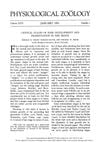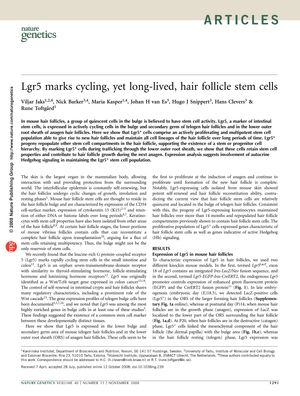TLDR Lgr5 is a marker for active, long-lasting stem cells in mouse hair follicles.
In 2008, researchers discovered that Lgr5, a gene marker known for identifying intestinal stem cells, also marks a population of cycling, yet long-lived stem cells in mouse hair follicles. These Lgr5+ cells are multipotent and contribute to all hair follicle structures, challenging the previous belief that hair follicle stem cells are quiescent and only reside in the bulge. The study demonstrated that these cells proliferate during the anagen phase and are essential for hair follicle maintenance and regeneration. Techniques such as immunohistochemistry, flow cytometry, cell cycle analysis, and transplantation experiments on nude mice were used to confirm the stem cell properties of Lgr5+ cells. The findings suggest a reevaluation of the relationship between label-retaining cells and hair follicle stem cells, indicating that a cycling population of stem cells maintains homeostasis in hair follicles. The study's experiments were conducted in triplicate to ensure reliability.
207 citations
,
July 2006 in “Development” MTS24 marks a new type of skin cell that helps hair growth and repair.
 375 citations
,
February 2006 in “Journal of Cell Science”
375 citations
,
February 2006 in “Journal of Cell Science” The document concludes that the hair cycle is a complex process involving growth, regression, and rest phases, regulated by various molecular signals.
421 citations
,
September 2003 in “Development” Stem cell behavior varies with stimuli, and lineage changes can happen without affecting stem cell division.
949 citations
,
January 2001 in “Cell” Adult mouse skin contains stem cells that can create new hair, skin, and oil glands.
1010 citations
,
August 2000 in “Cell” Hair follicle stem cells can form both hair follicles and skin.
333 citations
,
March 2000 in “Proceedings of the National Academy of Sciences” Overexpressing GLI-1 in mice skin can cause tumors like human basal cell carcinomas.
 236 citations
,
January 1951 in “Physiological zoology”
236 citations
,
January 1951 in “Physiological zoology” Hair growth and pigmentation in mice involve specific stages crucial for research.
 835 citations
,
October 2008 in “Nature Genetics”
835 citations
,
October 2008 in “Nature Genetics” Lgr5 is a marker for active, long-lasting stem cells in mouse hair follicles.
95 citations
,
July 2006 in “British Journal of Dermatology” Vitamin D receptors in hair follicles change with the hair cycle, affecting hair growth.
45 citations
,
April 2001 in “The journal of investigative dermatology/Journal of investigative dermatology” Different Myc family proteins are located in various parts of the hair follicle and may affect stem cell behavior.
10 citations
,
October 2000 in “PubMed” E6/E7 oncogenes in hair follicles cause continuous hair growth by skipping the resting phase.
69 citations
,
May 1997 in “Veterinary Pathology” The angora mouse mutation causes long hair and hair defects due to a gene deletion.



